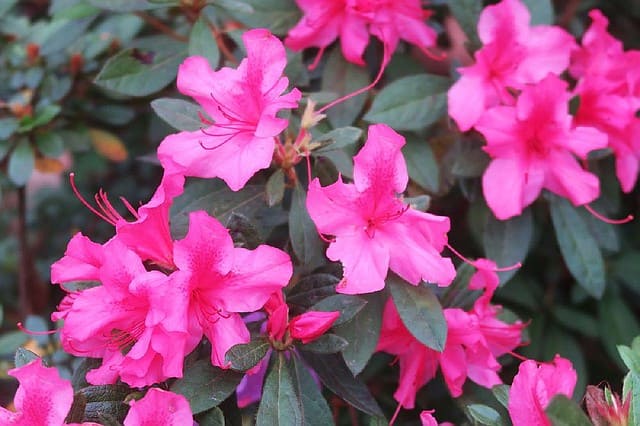Purple azaleas are a stunning addition to any garden, offering vibrant colors and a touch of elegance. These beautiful shrubs are known for their lush blooms and rich hues, making them a favorite among gardeners and landscapers. In this comprehensive guide, we will explore the various varieties of purple azaleas, provide detailed planting tips, and share essential maintenance practices to ensure your azaleas thrive.
Varieties of Purple Azaleas
Purple azaleas come in numerous varieties, each with its unique characteristics and charm. Here are some of the most popular ones:
- Encore Azalea ‘Autumn Royalty’
- Description: Known for its year-round blooming, ‘Autumn Royalty’ produces large, vibrant purple flowers.
- Growth Habit: This variety is compact and rounded, reaching up to 4 feet in height.
- Bloom Time: Blooms in spring, summer, and fall.
- Rhododendron ‘Purple Splendour’
- Description: ‘Purple Splendour’ is celebrated for its deep purple, almost bluish flowers with darker markings.
- Growth Habit: It grows upright and can reach heights of up to 6 feet.
- Bloom Time: Late spring to early summer.
- Azalea ‘Purple Delight’
- Description: This variety boasts small, vivid purple flowers that cover the plant profusely.
- Growth Habit: A low-growing, spreading shrub that can grow up to 3 feet tall.
- Bloom Time: Mid to late spring.
- Azalea ‘Hino Purple’
- Description: ‘Hino Purple’ offers bright purple flowers with a subtle red hue.
- Growth Habit: It is a dense, compact variety, growing up to 2 feet in height.
- Bloom Time: Early to mid-spring.
Planting Tips for Purple Azaleas
Proper planting is crucial for the success of your purple azaleas. Follow these steps to ensure your shrubs establish well and flourish:
- Choose the Right Location
- Sunlight: Purple azaleas thrive in partial shade, ideally with morning sun and afternoon shade. Too much direct sunlight can scorch the leaves and reduce blooming.
- Soil: They prefer acidic, well-drained soil with a pH between 4.5 and 6.0. Amend the soil with organic matter to improve drainage and fertility.
- Prepare the Soil
- Digging: Dig a hole twice as wide and as deep as the root ball of the azalea.
- Amendments: Mix the removed soil with compost or peat moss to enhance its texture and nutrient content.
- Planting
- Positioning: Place the azalea in the hole, ensuring the top of the root ball is level with the surrounding soil.
- Backfilling: Fill the hole with the amended soil, gently firming it around the root ball to eliminate air pockets.
- Watering: Water thoroughly after planting to settle the soil and establish good root contact.
Maintenance Practices for Healthy Purple Azaleas
To keep your purple azaleas healthy and vibrant, follow these essential maintenance practices:
- Watering
- Frequency: Water regularly, especially during dry spells. Azaleas prefer consistently moist soil but avoid waterlogging.
- Method: Use a soaker hose or drip irrigation to deliver water directly to the roots and minimize leaf wetness.
- Mulching
- Benefits: Mulch helps retain soil moisture, suppress weeds, and maintain soil temperature.
- Application: Apply a 2-3 inch layer of organic mulch, such as pine bark or wood chips, around the base of the plant. Keep the mulch a few inches away from the stem to prevent rot.
- Fertilizing
- Timing: Fertilize in early spring before new growth begins and again after flowering.
- Type: Use a balanced, slow-release fertilizer formulated for acid-loving plants. Follow the manufacturer’s instructions for application rates.
- Pruning
- Purpose: Pruning helps maintain the shape of the plant, encourages bushier growth, and removes dead or diseased branches.
- Timing: Prune immediately after the flowering season to avoid cutting off next year’s flower buds.
- Technique: Use sharp, clean pruning shears to make clean cuts. Remove any crossing or crowded branches to improve air circulation.
- Pest and Disease Control
- Common Pests: Watch for azalea lace bugs, spider mites, and caterpillars. Treat infestations with insecticidal soap or horticultural oil.
- Diseases: Purple azaleas can be susceptible to fungal diseases such as powdery mildew and root rot. Ensure proper spacing and air circulation, and avoid overhead watering to reduce disease risk.
- Winter Protection
- Mulching: Apply an extra layer of mulch in late fall to insulate the roots from freezing temperatures.
- Covering: In regions with harsh winters, cover azaleas with burlap or a frost cloth to protect them from cold winds and frost.
Conclusion
Purple azaleas are a stunning addition to any garden, offering vibrant colors and a touch of elegance. By choosing the right variety, planting them properly, and following essential maintenance practices, you can enjoy the beauty of these shrubs for years to come. Whether you opt for the year-round blooms of ‘Autumn Royalty’ or the striking flowers of ‘Purple Splendour’, your garden will be a testament to the charm of purple azaleas.


